Back to the top
After hitting rock bottom in 2005, Clark Wendlandt climbed back to the top to claim his third career AOY in 2009
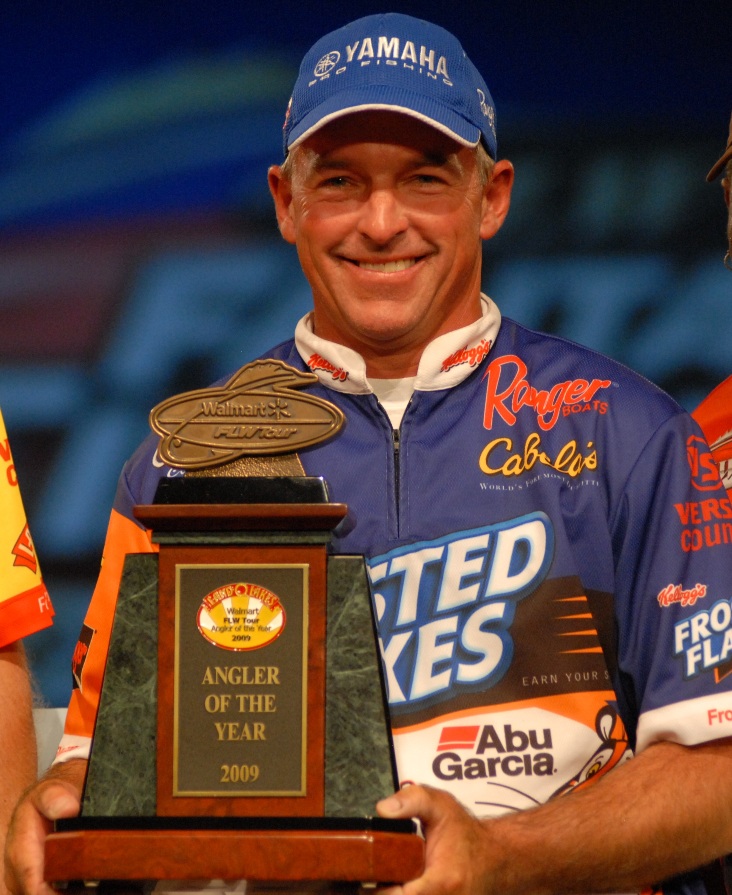
Clark Wendlandt‘s claim to his third FLW Tour Angler of the Year title did not start with the first cast of the 2009 season as many might think.
It did not start with his 35th-place finish at Guntersville, or his 20th-place at Table Rock nor his 14th-place showing at Norman. Even his third-place finish at Beaver Lake seemed to spark little change in Wendlandt’s thoughtful tenor while recounting his year.
His vocal tone did inflect a tad bit of swagger as he reviewed the final Champlain event where he finagled the AOY title away from two of the most talented pros on tour – Luke Clausen and Brent Ehrler – thanks to a seventh-place showing, but even then there was no eureka moment where the whole 2009 season turned on a dime and went his way.
After a few minutes of searching for the moment where things really changed for the better, the newly crowned AOY finally revealed that in order to fully understand the magnitude of 2009, scrolling back through the FLW annals to 2005 would be necessary.
“2005 was the absolute worst season in my entire fishing career,” Wendlandt quipped, fueled by the bitter memories of that particular season. “That’s probably where this whole journey back to the top began, because undoubtedly that was the lowest point.”
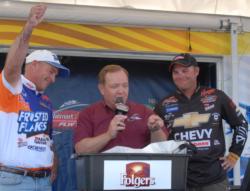
In 2005, Wendlandt started his year with a day-one zero at the season opener on Lake Okeechobee, and things never got any better until June. He went five straight tournaments without collecting a check, finished below 100th in most Tour events that year and missed qualifying for the Forrest Wood Cup for the first time in his FLW career.
He salvaged his 2005 season with a $100,000 runner-up finish at the Potomac River, but in Wendlandt’s mind the damage had already been done.
“Every tournament that season was like living a nightmare,” Wendlandt recalled. “After each hundred-and-something-place finish that season, I’d say, `This can’t be happening – I’m too good for this to happen.’ And then I would do even worse at the next event.
“And there’s the first lesson right there,” he said after a long pause, now carefully choosing his words. “I don’t know how to put this, but when you start thinking you’re too good in this sport, watch out. This is the most humbling sport in the world, and when you start thinking that you’ve got it all figured out and get complacent, the crater begins.”
Following the 2005 season, Wendlandt delved into a period of deep soul searching.
“I’m so competitive,” he continued. “After the 2005 season, I felt like I didn’t even deserve to fish professionally. To me it was not just a slump; it was a total crash and burn. In my book, it was simply unacceptable.
“Totally unacceptable,” he added more emphatically, punctuated by a dead silence.
During the 2005-2006 offseason, Wendlandt completely tore down his entire approach to tournament fishing – from his mechanics to his mental game – and formulated a long-term plan to get back to the top.
The following is a closer look at that path back to the top and the deliberate changes Wendlandt made to correct a career that was in crisis.
The complacency crater
Before his fateful 2005 season, Wendlandt’s FLW Tour fishing resume was as successful as they come, punctuated by three Tour wins and two previous FLW Angler of the Year titles in 1997 and 2000. In addition, he posted three consecutive top-five finishes in the Angler of the Year race from 2002 to 2004.
And with each successful season, the Kellogg’s pro put another brick in a wall that he eventually found himself trapped behind in 2005.
The “wall” Wendlandt refers to is his term for slowly closing himself off from bass fishing’s information highway. Armed with just a few techniques – namely shallow cranking, flipping, jerkbaiting and sight-fishing – the Texan became quite aloof in his own success and felt that staying up with the technology train was unwarranted.
“Once I found a couple of techniques that worked for me, I thought I had it all figured out,” he recalled. “I didn’t want to be distracted by all that `new’ stuff, so I walled myself into my comfort zone, and that’s a rut that starts the crater.
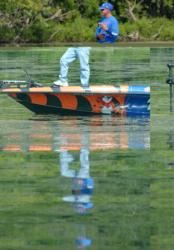 “When guys would talk about Senkos, shaky heads and wacky rigs, I’d just chuckle. I could tolerate Texas rigging, especially at Okeechobee, but I never even had a spinning rod or a Carolina rig in my boat back in those days.
“When guys would talk about Senkos, shaky heads and wacky rigs, I’d just chuckle. I could tolerate Texas rigging, especially at Okeechobee, but I never even had a spinning rod or a Carolina rig in my boat back in those days.
“I fished my way, and my way worked pretty well. I saw no need to change a thing. I was pretty content, and that’s probably where the problem started.”
With contentment came complacency. At tournaments he stayed with his family far away from the tournament humdrum and dock talk. During the offseason Wendlandt would put the boat away and go hunting.
And the farther he got from sources of fishing information, the more his competition began slipping by him. Bass fishing’s information superhighway – the Internet – was bustling with new techniques on a monthly basis, and Wendlandt was oblivious.
“I remember the first time I really paid attention to the Internet, things like fluorocarbon, drop-shots, swimbaits, Horny Toads and something called a ChatterBait were the common buzz among weekend anglers on chat boards, and I had no idea what half that stuff was,” he said. “That was really the first time I realized just how far out of touch I had become with the very sport I was supposed to be making a living in.”
Wendlandt likened his scenario to trying to land a job in today’s corporate world with no computer skills.
“If you go apply for a job and tell the interviewer you prefer typewriters and written letters delivered by the Post Office instead of computers and e-mail, they would probably laugh you out of the room. And that’s about where I was in 2005 – typewriters and letters – and I got laughed out of the room.”
And with that realization came a total change in attitude about technology and innovation.
“It all goes hand in hand,” he continued. “New lures, new techniques, new products like Power-Poles and new depth finders with capabilities like side-scan – it all comes at us fast thanks to the Internet. Technology is an undeniable part of our sport today, and you have to either embrace it or get left in the dust.
“If you choose to live in a cave, these younger guys coming up will eat you alive; they grew up in an age where information is instantaneous. Those kids in FLW College Fishing know more about a lake they’ve never seen before than ones I’ve been to two or three times.”
Indeed the playing field of modern-day bass tournaments now extends way beyond the lake. Thanks to the information age, competitive advantage is not just about who gets to the best fishing spot, it’s also about who has the right tools, lures and techniques when they get there.
“Tournament fishing is a new world compared to what it was 10 years ago, and that’s what 2005 taught me,” Wendlandt said. “Tournaments begin the minute they’re announced. There is no more offseason. Right now there are pros on the Internet ordering lures for the 2010 season, making hotel reservations for tournaments, studying the Red River on Google Earth – it’s a nonstop competition nowadays.”
Net work
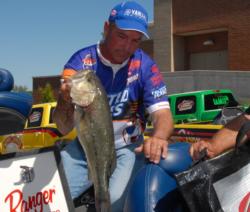
The first deliberate step Wendlandt made in picking up the pieces of his 2005 disaster was to establish a network of people to “just talk fishing with” again.
He rekindled a friendship with pro Davy Hite on the BASS Elite Series to trade information on new lure trends and techniques on the two tours. He began calling on old friends in Texas to see what was new on their fishing scene. He even began taking fishing advice from some of the better co-anglers on the FLW Tour, especially the younger, computer-savvy ones who mined the Internet for new fishing information on a daily basis.
And last, but certainly not least, he began sharing fishing information on Tour with fellow Tour competitor and longtime friend Mike Surman.
“Even five years ago I would have done none of those things,” Wendlandt said of the changes he made in opening himself up to the fishing world around him. “I used to do things my way and really didn’t care what anybody else did. But bass anglers – and consequently the bass – are constantly evolving. Years ago that evolution was so slow that you could make a decent living by being really good at a handful of techniques. But that evolution now occurs at warp speed thanks to technology. The average weekend bass angler is now so much better than the average weekend bass angler of 10 years ago.”
Wendlandt makes a poignant example of Bryan Thrift’s Stren Series win on Lake Okeechobee, which essentially broke the ChatterBait to the fishing world several years ago:
“If Bryan Thrift had won a national BASS tournament on a ChatterBait in 1985, the rest of the fishing world would not have really known about it for another year. And even then, the effectiveness of that bait would have lasted another three years. Back then pros had plenty of time to learn and apply new techniques before anyone else knew about them.
“These days, Bryan Thrift wins a regional Stren tournament on a ChatterBait, and half of the bass anglers in America have a dozen delivered to their front door the next day. Being ahead of those trends and tweaking them to your liking before bass get immune to them is a huge component of being successful these days.”
Wendlandt makes it clear he is not trying to glom on to every new lure that comes down the pike and win tournaments on them. It’s more about being aware of them, deciding if they are something to incorporate into his tournament arsenal and knowing the implications if he chooses not to use them.
“I used to pretty much ignore new stuff,” Wendlandt explained. “But the real danger in making a habit of that is losing touch with the way bass change over time. If I hear a guy wins a tournament on a ChatterBait and I have no idea what a ChatterBait is, then I don’t have any idea of how the fish were set up. No matter how bad I get beat in tournaments, I always want to know how the fish were set up. How can I know that if I don’t even know what things like a ChatterBait, a big spoon or a Sebile Magic Swimmer are?”
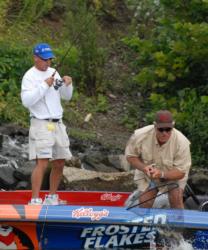
These days Wendlandt forces himself to tie on new lures and try new techniques – even if he has no intention of using them in tournaments – so he is at least familiar with them. He now spends more time experimenting and evaluating new things than he ever has before.
In addition to his own personal research, he relies on a network of friends who comb the Internet for innovations, lures and techniques as well as old out-of-production lures that are not sold in stores anymore.
“Don’t act like I’m the only pro who does this,” Wendlandt laughed after being prodded about having an entire private research team at his disposal. “I guarantee you: Check with the top 10 or 15 bass pros right now, and they’ve got the same thing going, some way, some how. They are networking all the time, keeping up with new things.
“Now, I will admit that I’m a pretty obsessive person,” he added with another laugh. “OK, I’m a real obsessive person, and I might be a little overboard on this issue right now. But like I said, professional bass tournaments are not just weekly events anymore; the competition is continuous, 24-7, 365.”
He also makes it clear that the kind of information he’s looking for is not waypoints from locals or specific brush piles. He is more interested in hearing about things like how blue-black herring are taking over in lakes along the Eastern Seaboard or how something like the Sebile Magic Swimmer has become a hot lure on those types of lakes.
“Exactly,” Wendlandt snapped at the example. “What I don’t like is going to a place like Hartwell or Clarks Hill and getting skinned alive on something I’ve never heard of.”
And despite his due diligence in trying to stay on top of the newest trends, he still gets blindsided in the Internet fishing arms race from time to time.
“Last year a lot of springtime fishing was dominated with the Reaction Innovations Skinny Dipper,” he recalled. “I never got the memo on that, and I’m still mad about it.
“I almost had to fire my whole research staff over that one,” he added with a chuckle.
The power of new
Hearing about new techniques or lures only starts the tedious task of experimentation and evaluation for Wendlandt. From there he orders the appropriate lures, materials, etc., and takes them to the lake (usually Lake Travis, his home lake in Texas) to try them out.
His goals for such offseason work are twofold: one is an attempt to keep up with the constant stream of innovation; the other is to find niche lures or techniques that can set off multitournament rolls of success.
“A lot of the new stuff I try, I’m simply not going to use,” he said. “I’ll try different types of shaky heads or the Flick-Shake-type deals just to make sure I have the best material to do it. I’ll try different rod actions, reels, weights, line types, line sizes, etc., to get it tweaked to my liking in case I have to do it. But by no means do I think I’m going to become the Flick-Shake master next year.”
Tinkering with such things often leads to small performance edges of which Wendlandt otherwise might not be aware. For instance, playing with drop-shots and trying different drop-shot hooks several years ago led Wendlandt to the magic of applying heat-shrink tubing to all his straight-shank flipping hooks to help keep plastics on the hook better.
“Small things like using bobber stoppers to peg weights or using uni-knots and Super Glue to fuse braided line with fluorocarbon leader all add up to more efficient fishing,” he pointed out. “Several years ago I would have never even paid attention to these improvements, but today I consider it a basic job requirement to keep up.”
The real bonus to such evaluative tedium is discovering niche lures or techniques that, according to Wendlandt, are lethal confidence boosters.
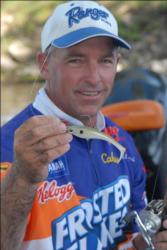
As examples he cites Dean Rojas and his frog, Kelly Jordon and the big spoon, Craig Powers and a Long A, and Chris Baumgardner with a ChatterBait.
Wendlandt believes the tremendous amount of confidence these pros garner from their specific niche lures transcends into their overall fishing. Such lures can be the catalyst for setting off runs of phenomenal success.
Wendlandt makes it clear that he’s not trying to tap into a single signature technique like David Fritts with a crankbait, where that is all he does no matter where he goes. Rather he wants a handful of niche techniques that become aces in a rod locker at certain times.
“Dean Rojas and his frog and Kelly Jordon and the big spoon are perfect examples of what I’m talking about,” Wendlandt said. “Discovering little niche baits like that makes fishing fun again, they fire you up, and that supreme confidence spills over into all the other aspects of your fishing.”
As for Wendlandt, he had just two minor examples of this in 2009: the Wiggle Wart and the Berkley Hollow Belly swimbait.
“Those are small examples because everyone pretty much knows about them,” he said. “The old Wiggle Wart is a good bait for Table Rock, and the swimbait is something I tinker with incessantly to find just the right weight-and-hook combo for certain situations. The swimbait was a big bonus for me at Champlain when fishing the grass in Ticonderoga. I only weighed in a couple of fish on it in that tournament, but they were good ones. And those are the little things that add up. Without those two fish, I would not have made the top-10 (cut), and Luke would be the 2009 Angler of the Year.”
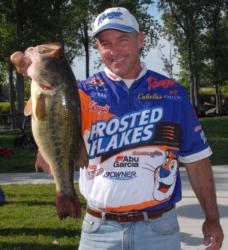
Surman’s solace
Wendlandt will not speak to the success of his 2009 Angler of the Year title without giving credit to his longtime friend and traveling roommate Mike Surman.
The notion of teaming up with another Tour pro and sharing exclusive information was something Wendlandt would have never considered, except that he had watched the team concept work effectively for Tour pros Koby Kreiger and Craig Powers.
“I had talked general fishing stuff with roommates in the past, but sharing every detail of every practice and tournament day with another competitor is something I was pretty apprehensive about,” Wendlandt explained. “Here’s the thing with sharing information like that: You become extremely vulnerable when you do it, because if the person you’re sharing information with leaves out one critical thing – either intentionally or unintentionally – it can train wreck you, which is exactly why I’ve always been a do-it-all-myself kind of angler; I want no one to blame but myself. With so much at stake out here – pride, egos and large sums of money – losing a great friendship over a fishing spot is not worth it to me, so I have never pursued it.
“But here’s the flipside to that,” he countered. “If two great fishermen could ever make it work, I think they could dominate the fishing scene for a while. When it comes to covering and processing water, two pairs of eyes and two heads are certainly better than one. Again, that’s something I’d never thought I’d say or even agree with five years ago, but just as multicar teams now dominate NASCAR, it could definitely be a reality in professional fishing.”
After several similar discussions, Wendlandt and Surman made a pact to room together for the 2009 season and exchange everything – every last detail of their fishing efforts during practices and tournaments.
The result?
“I would not have won the Angler of the Year title if it was not for Mike Surman – it’s that simple,” Wendlandt stated. “All I can do is be open and honest about it. I’m not going to sit here and act like I did it all myself this year, because that’s simply not true. Surman helped me more than he probably knows.”
In seasons past Wendlandt traveled with his wife and two daughters. And while he loved having his family at tournaments, he could not exactly come off the water every day and talk detailed fishing strategy with them.
“It was a new experience to come back to the room every night and have in-depth fishing conversations with someone who had been out there all day,” Wendlandt explained. “Surman was an excellent sounding board to bounce ideas and thoughts off of.”
In some tournaments, Surman found productive areas and offered them to Wendlandt, and in other tournaments Wendlandt relinquished his areas to Surman.
“Guntersville and Champlain were two places that his help really paid off,” Wendlandt said. “Surman understands grass fishing pretty darn well, and he found the right stuff in those two tournaments.”
But what Wendlandt valued even more than the fishing information was Surman’s friendship, which helped tremendously in diffusing the stress levels of the season.
“I’m not going to lie; I get wound up pretty tight at tournaments,” Wendlandt offered with a laugh. “Surman is relaxed, easygoing and absolutely hilarious to be around. His dry sense of humor during the tensest times this past season totally kept me in check. He kept me from obsessing and worrying myself to death every second of the day.”
Surman believes he and Wendlandt’s relationship works because they have different long-term goals. Though Surman loves to fish tournaments, he makes his living as a successful electrical engineer for Siemens Corporation.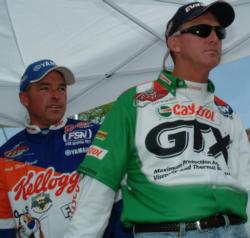
“We’re longtime friends and both love fishing,” Surman related. “But fishing is his living. I’m fortunate in that I have a great job and don’t have to rely on fishing solely for my income. At the same time, I work hard at fishing, too, and want to do the best I possibly can. We put everything on the table every night, and it helps both of us.
“And please, it’s not like three-time Angler of the Year Clark Wendlandt is riding my coattails, OK,” Surman continued. “Believe me, he works harder at this than anyone else, and most of the time he doesn’t even want my help – he wants to do it all himself – and I know that. But if I discover a little piece of the puzzle that he needs, I’m going to give it to him.
“I’ve known Clark a long time,” Surman said. “He’s an awesome fisherman, but in my opinion he’s got one nemesis that holds him back from being absolutely awesome: He’s very analytical, and he beats himself up too much when the smallest things go wrong. He’s wants to plan out every detail of a tournament day, and you just can’t do that in tournament fishing; there are too many things out of your control. You have to go with the flow, kind of dance with what the day gives you and be in a position to seize certain special opportunities when they present themselves.
“Clark is at his best as a fisherman when he is loose, freewheeling and fishing from the hip, and that’s where I try to keep him mentally. I try to keep the frantic, obsessive Wendlandt away at tournaments, and trust me, that’s a full-time job because the guy is some kind of obsessive.”
And when given a chance to rib his Angler of the Year friend publicly, Surman does not stop at Wendlandt’s obsessiveness.
“Yeah, he’s got some issues,” Surman chuckled. “He absolutely thrives on misery, especially mine. If it’s 18 degrees and snowing outside, he’s giddy about it. He can’t wait to get out there in it because he knows I hate it. The more miserable the conditions are, the more he wants to go fishing. Table Rock this year was brutal – sleet, snow, wind chills in the teens all day – and he was like a pig in slop; he just loved it.
“I’m from Florida, and I was freezing. Each day of that tournament I had to wear every piece of clothing I brought with me, and he thought it was hilarious. We rented this little two-room cabin with one heater – guess whose room had the heater? Yep, that’d be Wendlandt’s room. What did my room have in it? A broken window, letting 15-degree air in all night. It was so cold in my room I had to sleep in my rain suit. Every time my teeth would start chattering, he’d just laugh until he cried. I don’t know why, but that man loves my misery.
“Also, he is so competitive. Everything is a contest: Who can rig tackle the fastest? Who can tie a better knot? Who has the strongest split rings?
“When we go to dinner, it’s, Who can eat the fastest? Who can drink the most iced tea? Who can eat the most chips? And he especially likes contests of pain: Who can eat the hottest salsa? Who can eat the most jalapenos? It never ends.
“And I’m telling you, no one gets up earlier than he does. Each day of practice he gets up earlier and earlier. It won’t get light until 6:30, and Wendlandt’s setting the darn clock for 4 a.m. Then he’ll ask me, `Is 4 o’clock too early?’ If I say yes, he’ll set it for 3:30!
“The man operates on zero sleep!” Surman continued. “At both Kentucky Lake and Champlain, we had to get up in the middle of the night every night of practice so we could trailer our boats for three hours to where he wanted to practice. It was insane! Some nights we would go to bed at midnight and then get up at 3 a.m. And here’s the brutal part: He wakes up so dang happy. He pops up like toast, just a singing and a whistling like he’s had more rest than Rip Van Winkle. One thing is for sure: He absolutely loves this sport.”
When these instances of alleged roommate abuse were brought to Wendlandt’s attention for verification, it only sent him into fits of uncontrolled laughter.
“I’m telling you,” Wendlandt gasped, trying to catch his breath. “Surman is hilarious. I felt so bad for him at Table rock; I offered him some of my long underwear, and they came up to his knees … (laughing)
“…and to hear Surman’s reaction when that clock goes off at 3:30 in the morning. From the other side of the room he’d yell, `You’ve got to be kidding me! We just went to sleep five minutes ago!’
“I don’t know why, but he kills me,” Wendlandt added. “To wake up laughing like that is a great way to start the day. And that right there is what made this year possible for me; I can’t thank Surman enough for those times.”
The view from the top
As Clark Wendlandt looks back over his fishing career from his 2009 Angler of the Year perch, he’s even amazed at his own progress at opening up and loosening up as an angler.
When he began his career in 1992, he was a self-described bulldog.
“I fished with such reckless abandon back then,” he revealed. “I had very little tact and could care less about other fishermen, other techniques, who was doing well – whatever. I can remember fishing early BASS events where I didn’t even know what place I was in during the tournament, because if it wasn’t first, I didn’t care. I was a bull in China shop. Considering that, I do things these days that 20 years ago I would have never dreamed of.”
Some specific surprises that stick out in Wendlandt’s mind about his season include using spinning tackle for the entire tournament at Norman, thanks in large part to braided line.
“Up until last season I never even carried a spinning rod on Tour,” he admitted. “Berkley Fireline has single-handedly made spinning rods tolerable for me. In the old days with mono that fluffed up into a dozen wind knots on every other cast, I couldn’t handle it. But once I learned how to tie a uni-knot to join 10-pound-test Fireline to a 10-pound-test fluorocarbon leader, finesse-fishing became much more feasible for me.”
On two occasions this season, Wendlandt “stooped so low” as to throw Carolina rigs: at Beaver Lake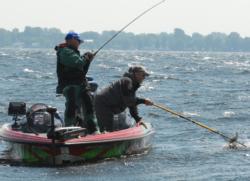 and Lake Champlain. Needless to say, his aversion to spinning tackle pales in comparison to his disdain for the Carolina rig.
and Lake Champlain. Needless to say, his aversion to spinning tackle pales in comparison to his disdain for the Carolina rig.
“Hey, I figured if I was throwing my foolish pride out the window, no need in stopping with spinning tackle,” he joked. “While I’m at it, I might as well throw Carolina rigs too.”
The Carolina rig was actually a clutch play for Wendlandt on day three at the final event on Lake Champlain. After running to Ticonderoga the first two days of the event to focus on largemouths in shallow grass, day three greeted the top 10 pros with high winds and rough seas.
In a last-second decision, Wendlandt ditched his run to Ticonderoga, headed toward Rouses Point on the northern end of Champlain and drifted around in 3-foot waves with a Carolina rig. He dragged up 12 pounds, 12 ounces of smallmouth with the rig, which may not sound like much, but it ultimately allowed him to distance himself from Chevy pro Luke Clausen, his only other AOY rival in the top 10.
In hindsight, it was the most pivotal day of his season and, in an ironic way, the most reflective for how Wendlandt has matured as a pro.
“Four or five years ago that would have never happened,” he revealed. “I would have never dropped back and punted like that with an Angler of the Year title on the line. The bulldog in me would have forced the issue of going south in those 4- and 5-footers and power-fishing down in Ti. And who knows? Maybe I still would have caught enough down there to beat Luke, but I’ve got a feeling it would have been a critical mistake.”
Wendlandt’s 2009 Angler of the Year journey is a conglomeration of bits and pieces, perhaps small rewards, for in essence tearing down the “wall” he found himself behind in 2005.
“Who knows? Maybe I’m getting a little smarter or maybe some self-humility is starting to set in,” Wendlandt said in a moment of reflection on the year. “Or maybe it’s some combination of both. I’ve certainly learned that I can’t wall myself into a comfort zone with just a handful of techniques and think I’m going to do it my way 100 percent of the time – the competition out here is way too good, especially among the younger pros. And that’s why this Angler of the Year title is the sweetest one yet.”